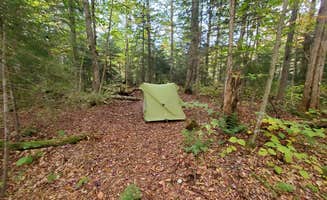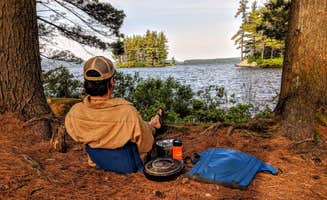Dispersed camping options surround Ray Brook, New York within the Adirondack Forest Preserve at elevations ranging from 1,600 to 2,400 feet. The region receives approximately 40 inches of annual precipitation, creating lush forest conditions. Road access to many sites deteriorates significantly during spring thaw and after heavy rainfall, requiring appropriate vehicle clearance.
What to do
Kayaking on Cranberry Lake: Multiple designated backcountry sites on islands provide water-accessible camping. "We spent 3 nights backcountry camping on Catamount Island in Cranberry Lake and absolutely loved it! The sunsets from the island were truly incredible," notes a visitor to Cranberry Lake Backcountry Sites.
Fishing from natural platforms: Several sites offer direct lake access with natural fishing spots. At Crane Pond Dispersed Site, one camper describes "a stone cliff near it that goes down about 12 feet and is great for fishing or jumping off of. There is also a stone area right by the water if you want to fish or just sunbathe."
Hiking nearby trail networks: Most primitive sites connect to hiking trails. "Curtis Pond hike was our favorite and there are some incredible beaver dams along the way," reports a Cranberry Lake camper. Sites often serve as base camps for day hikes into the surrounding wilderness.
What campers like
Complete disconnection: The isolation provides true wilderness immersion. "Camped here for a few days, no cell, no internet," writes a visitor to Polliwog Lake on Floodwood Road, highlighting the digital detox experience available.
Sheltered campsites: Tree cover characterizes many sites. "Tree covered sites," notes a reviewer at Little Green Pond, describing "12 designated camping spots. Some require driving down a bumpy access road that can be muddy after a rain. Sites are on the Pond."
Spacious, uncrowded setting: Sites typically provide adequate separation between campers. One visitor to Cranberry Lake describes "sites not crowded together," contributing to the secluded experience. Many dispersed sites allow campers to spread out with minimal neighbor interaction.
What you should know
Vehicle requirements: Rough access roads demand appropriate vehicles. "Crane Pond Road from the lower parking lot to the pond itself is NOT maintained and often gets very muddy. 4WD is required, if you go back there without it your day is gonna suck," warns one camper at Crane Pond.
Limited supplies available: Prepare to bring all necessities. A Cranberry Lake visitor advises, "The Village of Cranberry Lake has some supplies, but not much except the very basics at the general store. You'll need to head to Star Lake or Tupper Lake for anything of significance."
Water filtration essential: Natural water sources require treatment. "You will either need to bring your own potable water or filter from the lake, so don't forget your water filter," suggests a Cranberry Lake camper. Most sites lack potable water, requiring campers to filter from lakes or streams.
Tips for camping with families
Bug protection planning: Insect activity varies by location and season. "While the mosquitoes weren't bad at the campsite itself or while kayaking, they are terrible on the trails this time of year; so bring your bug spray, or better yet, bug shirts!" recommends a visitor to Horseshoe Lake.
Swimming access considerations: Some sites offer child-friendly water entry points. "Pond has a small beach to swim," notes a Little Green Pond visitor, highlighting water recreation potential for families.
Wildlife viewing opportunities: Natural habitats support diverse wildlife. "The millions upon millions of dragonflies help make up for the mosquitoes!" observes a Cranberry Lake camper. Evening hours often bring opportunities to hear loon calls across the water bodies.
Tips from RVers
Size restrictions: Most primitive sites accommodate smaller vehicles only. "Not fit for an RV in any capacity," cautions a Crane Pond visitor regarding access roads. Class B campervans may navigate some routes during dry conditions.
Solar limitations: Forest cover impacts power generation. "As it's a forest, the sites are pretty shaded, so solar and Starlink may present challenges," explains a visitor to Horseshoe Lake, noting "Slight AT&T at earlier sites."
Alternate parking options: When road conditions prevent direct access, alternative arrangements exist. "The only fee is if you want to park your vehicle in the state park while you are camping on the island, it is $8 per day," explains a Cranberry Lake visitor, describing boat-in camping logistics.



